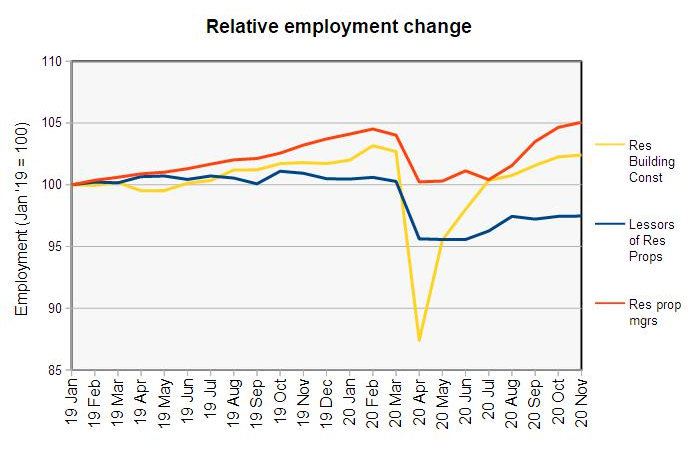Two recent reports from the Bureau of Labor Statistics (BLS) describe the current labor situation. They are the Employment Situation Report for December and the Job Openings and Labor Turnover (JOLT) report for November. They show a stagnant labor market.
Total employment stagnant
The BLS reported that the US unemployment rate remained at 6.7 percent in December, despite a drop of 140,000 in total non-farm employment. Note that the total labor force is nearly 150 million people. The labor force participation rate remained unchanged for the month at 61.5 percent of the adult population.
The BLS also reported more detailed employment information on three job categories of interest to the multifamily industry. These are employment as residential construction workers, as residential property managers and as lessors of residential buildings. As usual, this more detailed data was reported with a month delay, so the latest figures are for the month of November. The first chart, below, shows the employment in these job categories relative to their levels in January 2019.

The chart shows that residential construction employment has rebounded strongly from the low point it reached in April as the economy was shut down. The preliminary figure for November shows a small increase in employment for the month, the seventh month in a row where residential construction employment has grown. Employment in this category is also 0.6 percent higher than its level in November 2019.
Employment for residential property managers has recovered more strongly, but less evenly, than has residential construction employment. The preliminary figure for November puts employment in this category up 0.4 percent for the month and 1.8 percent higher than its year-earlier level.
The recovery of employment for lessors of residential buildings continues to lag. The preliminary reading on employment of lessors of residential buildings for November came in at 354,600. This was up 0.4 percent from October but was down 3.4 percent compared to November 2019.
Looking at the churn
The JOLT report has more detail about openings, hiring and separations, but it breaks the jobs market into coarser categories. Therefore, while the Employment Situation Report separates residential construction from other construction, the JOLT report does not. The JOLT report gathers all rental and leasing employment, even for non-residential property, into a single category. However, the JOLT report provides a look under the covers on how the employment gains (or losses) came about.
Overall labor market cooling
The JOLT report shows that the overall private labor market has a high number of hires and separations even in a “normal” jobs market. The net gains or losses in employment are based on small differences between these two large numbers.
The JOLT report for November showed that the slow recovery in the labor market continued during that month. This is shown in the next chart, below.

The preliminary November readings show the slowest pace of job gains since the recovery began in May. While hiring picked up from October’s level, separations increased even more. The rise in the number of separations was driven almost entirely by an increase in the number of involuntary separations (layoffs), which rose to nearly 3 million on a seasonally adjusted, annualized basis. Layoffs are up over 36 percent from the recent low they reached in September. Voluntary separations (quits) were up less than 1 percent for the month.
Construction jobs growth continues to slow
The second chart shows the employment situation for the construction jobs market. Since July, the number of openings has changed month-to-month as has the number of separations. However, the monthly number of hires has been almost unchanged. Therefore the change in the rate of job growth since July has been caused almost entirely by changes in the number of separations.
In November, the number of separations was up, driven by an increase in the number of quits. Quits rose from 122,000 to 146,000 on a seasonally adjusted, annualized basis, while layoffs fell slightly. Still, the construction jobs market experienced another month of job gains. The JOLT data indicate that the construction jobs market has recovered 93 percent of the jobs lost in March and April. This is shown in the next chart, below.

RERL recovering slowly
The real estate and rental and leasing (RERL) jobs market, which includes people who manage multifamily properties, experienced a sharp jump in jobs growth in November, according to the JOLT data. This is shown in the last chart, below.

The preliminary figures for November showed that hiring was actually down in this category, but a 33 percent fall in separations caused jobs growth to turn sharply positive. Within separations, both quits and layoffs were down significantly, leading to the sharp drop. Despite the strong performance in November, the overall recovery of jobs in this category has been very anemic with nearly ¾ of the jobs lost in March and April not having come back.
The numbers given in the JOLT and Employment Situation reports are seasonally adjusted and are subject to revision. It is common for small adjustments to be made in subsequent reports, particularly to the data for the most recent month. The full current JOLT report can be found here. The current Employment Situation report can be found here.












